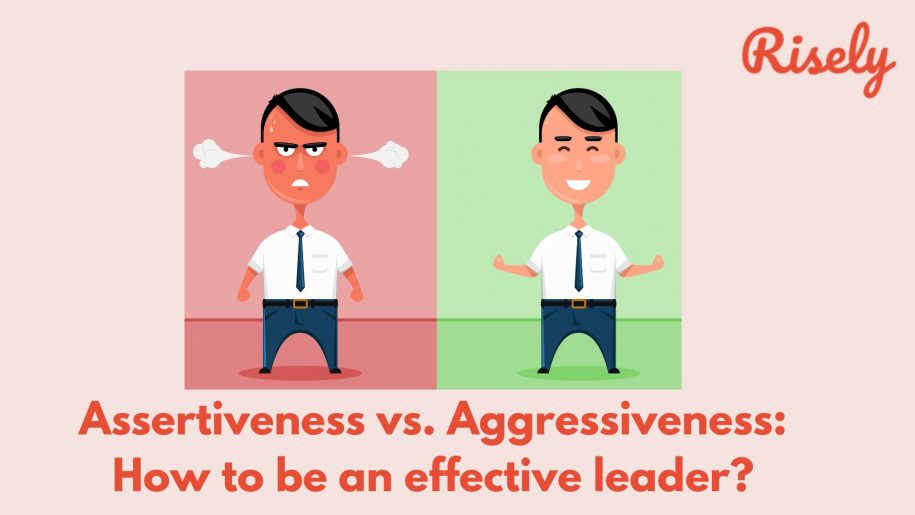Assertiveness vs. Aggressiveness: How to be an effective leader?
Finding the right approach to guide and inspire a team can be a delicate tightrope walk. How managers communicate and assert authority can significantly impact team dynamics, productivity, and overall success. It’s a fine line to tread, and it all boils down to the art of assertiveness vs. aggressiveness. Imagine a workplace where the manager’s words carry weight without striking fear, open communication flows effortlessly, conflict is resolved constructively, and employees are motivated to give their best. This is the realm of assertive leadership, where managers strike the perfect balance between firmness and respect, nurturing a productive and positive work environment. On the other hand, envision a scenario where the manager’s presence looms like a dark cloud, where fear and anxiety overshadow creativity, and conflicts escalate into battlegrounds. This is the realm of aggressive leadership, a toxic landscape where communication is laced with hostility, trust is shattered, and team performance suffers under the weight of demoralization. This blog delves into the captivating world of assertiveness vs. aggressiveness in management. We’ll explore the key differences between the two approaches, the traits that set them apart, and their impact on teams and individuals.What is assertiveness?
Assertiveness refers to the ability to express one’s thoughts, feelings, and needs in a clear, direct, and respectful manner while also considering the rights and opinions of others. It is a communication and behavior style that promotes open and honest expression, confidence, and self-assuredness without infringing upon the rights and boundaries of others. Learn more about the assertive communication style here: Assertive communication styles: Learn about your communication style as a managerWhat is aggressiveness?
Aggressiveness refers to a behavior or communication style characterized by forcefulness, hostility, and a disregard for the rights and feelings of others. It involves a proactive approach to achieving one’s goals or asserting one’s dominance, often at the expense of others. Aggressive behavior can manifest in various forms, including verbal, physical, or passive-aggressive actions.Traits of assertive vs. aggressive manager
Traits of an Assertive Manager
- Clear and Direct Communication
- Respect for Team Members
- Active Listening
- Constructive Feedback
- Collaboration and Empowerment
- Setting Clear Expectations
- Conflict Resolution
Traits of an Aggressive Manager
- Intimidating communication
- Micromanagement
- Lack of empathy
- Blaming and criticism
- Authoritarian approach
- Unreasonable expectations
- Lack of collaboration
Other Interesting Reads
Difference between Assertiveness vs. Aggressiveness
Assertiveness vs. aggressiveness is two distinct communication and behavior styles with significant differences in approach and impact. The key differences between assertiveness vs. aggressiveness: Communication style- Aggressive communication involves forceful, hostile, and confrontational language, tone, and body language. It aims to overpower, intimidate, or dominate others.
- Assertive communication is direct, clear, and respectful. It involves expressing one’s thoughts, feelings, and needs confidently and respectfully without violating others’ rights.
- Aggressive individuals tend to disregard or violate the rights, boundaries, and feelings of others. They prioritize their own needs and objectives over those of others.
- Assertive individuals respect both their rights and the rights of others. They communicate their boundaries and expectations while considering the perspectives and rights of those they interact with.
- Aggressive behavior often involves intense emotional expression, such as anger, frustration, or hostility. Emotions may be displayed in an uncontrolled or reactive manner.
- Assertive individuals express their emotions in a controlled and appropriate manner. They can communicate their feelings without being overwhelmed, maintaining a calm demeanor.
- Aggressive individuals approach conflicts with a win-loss mindset. They may resort to personal attacks, blaming, or manipulative tactics to gain an advantage.
- Assertive individuals seek win-win solutions in conflicts. They address issues directly, express their concerns without attacking others, and work collaboratively towards finding mutually satisfactory resolutions.

- Aggressive behavior damages relationships, erodes trust, and creates a hostile or fearful environment. It can lead to strained interactions, resentment, and reduced cooperation.
- Assertive behavior fosters positive relationships built on trust, mutual respect, and open communication. It promotes healthy collaboration, understanding, and teamwork.
- Aggressive individuals may display confidence, but it often stems from dominance or control. Their confidence may be rooted in an overpowering demeanor rather than genuine self-assuredness.
- Assertive individuals are confident and self-assured based on their self-worth, knowledge, and abilities. Their confidence comes from their belief in themselves and their ability to express themselves effectively.
Benefits of an Assertive manager
- Clear communication: Assertive managers effectively communicate their expectations, instructions, and feedback to their team members. They use clear and concise language, ensuring that messages are understood.
- Fosters open communication: An assertive manager creates an environment where open communication is encouraged. Team members feel comfortable expressing their thoughts, concerns, and ideas without fear of judgment.
- Conflict resolution: Assertive managers are skilled at addressing conflicts at work constructively and timely. They approach conflicts with a focus on understanding all perspectives, finding common ground, and facilitating a resolution that satisfies the needs of all parties involved.
- Empowers team members: Assertive managers empower their team members by giving them autonomy, trust, and responsibility. They delegate tasks and allow employees to make decisions.
- Sets and maintains boundaries: Assertive managers set clear boundaries and expectations for their team members. This clarity helps to minimize confusion and conflict.
- Encourages growth and development: Assertive managers actively support the growth and development of their team members. They provide constructive feedback, identify areas for improvement, and offer opportunities for professional advancement, which helps employees enhance their skills and reach their full potential.
- Improves employee satisfaction and retention: Having an assertive manager who values open communication, supports personal and professional growth, and maintains a positive work environment enhances employee satisfaction and reduces turnover.
Drawbacks of Aggressive manager
- Toxic work environment: Aggressive managers create a toxic environment characterized by fear, tension, and anxiety. Their hostile behavior and intimidating communication style can negatively impact employee morale, well-being, and job satisfaction.
- Decreased productivity: Aggressive managers may believe their forceful approach motivates employees to work harder. However, in reality, it often leads to decreased productivity. Employees may become disengaged, fearful of making mistakes, or reluctant to contribute ideas and suggestions due to the hostile environment created by the manager.
- Increased turnover: Aggressive managers contribute to higher employee turnover rates. Employees who experience ongoing aggression and hostility are more likely to seek other job opportunities where they feel valued, respected, and supported.
- Poor communication and collaboration: Aggressive managers hinder effective communication and collaboration among team members. The fear of retaliation or criticism may discourage employees from sharing their thoughts, concerns, and innovative ideas.
- Impact on mental and physical health: Working under an aggressive manager can harm employees’ mental and physical health. Constant stress, fear, and anxiety can contribute to burnout, decreased well-being, and even physical health issues. This can lead to higher absenteeism rates.
- Lack of innovation and creativity: Aggressive managers stifle innovation and creativity within their teams. Employees may hesitate to share new ideas or take risks due to fear of criticism or retribution. This stifles innovation and prevents the team from benefiting from its employees’ diverse perspectives and ideas.
- Reputation damage: An aggressive manager’s behavior can damage the team’s internal and external reputation. Word spreads quickly about negative work environments, leading to difficulties attracting and retaining top talent.

How can managers be assertive without being aggressive?
Managers can adopt an assertive approach without crossing into aggression by practicing the following strategies:- Self-awareness: Managers should develop self-awareness and recognize their emotions, triggers, and communication style. Being mindful of their behavior allows them to consciously choose assertive responses over aggressive reactions.
- Active listening: Managers should listen to their team members, demonstrating genuine interest and empathy. This involves giving full attention, seeking to understand perspectives, and acknowledging the thoughts and feelings of others without interrupting or dismissing them.
- Use “I” statements: When expressing concerns, providing feedback, or discussing issues, managers can use “I” statements to convey their thoughts and feelings without sounding accusatory or confrontational.
- Respectful language and tone: Managers should use respectful language and maintain a calm and composed tone when communicating with their team members. Avoiding harsh or derogatory language and adopting a respectful tone fosters a positive and collaborative atmosphere.
- Constructive feedback: Instead of solely focusing on mistakes or shortcomings, managers can provide constructive feedback highlighting areas for improvement and strengths. They can offer specific suggestions and support to help employees grow and develop.
Conclusion
In leadership, the distinction between assertiveness vs. aggressiveness holds immense significance. As we conclude our exploration of assertiveness vs. aggressiveness in the realm of managerial prowess, you have gained valuable insights into the impact of these approaches on teams and individuals. Assertiveness, emphasizing effective communication, mutual respect, and open collaboration, emerges as the winning path for managers seeking to create a positive and productive work environment. By adopting an assertive leadership style, managers can inspire trust, motivate their teams, and foster a culture of innovation and growth. On the other hand, aggressiveness, with its hostile demeanor, fear-driven communication, and disregard for the well-being of others, proves to be a detrimental force in the workplace. The toxic work environment created by aggression becomes a breeding ground for conflicts, demoralization, and diminished productivity. So, let us step forward, and become the assertive leaders who shape the future of our teams.Assertiveness helps you grow. Aggressiveness hurts your team!
Ensure you are not crossing the border over to aggressiveness with the free assertive communication assessment now.
Frequently asked questions:
How does assertiveness different from aggression?
Assertiveness differs from aggression in several key ways.
Assertiveness:
– It involves expressing one’s thoughts, feelings and needs directly and respectfully.
– Promotes open and effective communication, collaboration, and problem-solving.
Aggressiveness:
– It involves expressing thoughts, feelings and needs in a hostile, forceful, or disrespectful manner.
– Hinders effective communication, collaboration, and problem-solving.
Assertiveness:
– It involves expressing one’s thoughts, feelings and needs directly and respectfully.
– Promotes open and effective communication, collaboration, and problem-solving.
Aggressiveness:
– It involves expressing thoughts, feelings and needs in a hostile, forceful, or disrespectful manner.
– Hinders effective communication, collaboration, and problem-solving.
What are examples of assertive and aggressive?
Examples of assertive behavior:
– Expressing opinions and ideas confidently in a team meeting.
– Setting clear boundaries and saying “no” when necessary.
Examples of aggressive behavior:
– Yelling, shouting, or using a hostile tone in communication.
– Interrupting or dismissing others’ opinions without consideration.
– Expressing opinions and ideas confidently in a team meeting.
– Setting clear boundaries and saying “no” when necessary.
Examples of aggressive behavior:
– Yelling, shouting, or using a hostile tone in communication.
– Interrupting or dismissing others’ opinions without consideration.
Other Related Blogs
Assertive Feedback Techniques ft. Gurleen Baruah
Assertive Feedback Techniques ft. Gurleen Baruah Let’s be real—giving feedback as a manager isn’t always easy. Say too little, and nothing changes. Say too much, and it might come off…
Assertive Conflict Resolution Techniques | Brenda Hooper
Assertive Conflict Resolution Techniques | Brenda Hooper Can assertive communication help you out in resolving conflicts? In this podcast conversation, we have Brenda Hooper, an experienced executive coach joining us…
The Best Assertiveness Coaches To Transform The Way You Interact
The Best Assertiveness Coaches To Transform The Way You Interact Effective communication is paramount in the dynamic world of business and leadership. Yet, finding the balance between being passive and…
Assertive Communication for Managers: 5 Hacks to Master the Skill
Assertive Communication for Managers: 5 Hacks to Master the Skill A manager’s communication skills can make or break the success of an organization. From leading others and making crucial decisions…


